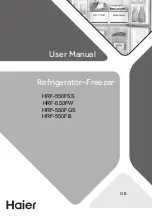
Troubleshooting
GB
GB
Troubleshooting
Problem
Possible Cause
Possible Solution
It is not cold enough
i
nside th
e appli-
ance.
•
The temperature is set too high.
•
Too warm goods has been stored.
•
Too much food has been stored at
one time.
•
The goods are too close to each
other.
•
A door/drawer of the appliance is
not tightly closed.
•
The door/drawer has been opened
too frequently or for too long.
•
Reset the temperature.
•
Always cool down goods be-
fore storing them.
•
Always store small quantities of
food.
•
Leave a gap between several
foods allowing air flowing.
•
Close the door/drawer.
•
Do not open the door/drawer
too frequently.
I
t is too cold i
nside
th
e appliance.
•
The temperature is set too low.
•
The Power- freeze function is acti-
vated or is running too long.
•
Reset the temperature.
• Switch off the Power- freeze
function
Moisture formation
on the inside of the
refrigerator com-
partment.
•
The climate is too warm and too-
damp.
•
A door/drawer of the appliance is
not tightly closed.
•
The door/drawer has been opened
too frequently or for too long.
•
Food containers or liquids are left
open.
•
Increase the temperature.
•
Close the door/drawer.
•
Do not open the door/drawer
too frequently.
•
Let hot foods cool to room
temperature and cover foods
and liquids.
Moisture accumu-
lates on the refrig-
erators outside
surface or between
the doors/door and
drawer.
•
The climate is too warm and too
damp.
•
The door/drawer is not closed
tightly. The cold air in the appliance
and the warm air outside it con-
densates.
•
This is normal in damp climate
and will change when the hu-
midity decreases.
•
Ensure that he door/drawer is
tightly shut.
Strong ice and frost
in the freezer com-
partment.
•
The goods were not adequately
packaged .
•
A door/drawer of the appliance is
not tightly closed.
•
The door/drawer has been opened
too frequently or for too long.
•
The door/drawer gasket is dirty,
worn, cracked or mismatched.
•
Something on the inside prevents
the door/drawer to close properly.
•
Always pack the goods well.
•
Close the door/drawer.
•
Do not open the door/drawer
too frequently.
•
Clean the door/drawer gasket
or replace them by new ones.
•
Reposition the shelves, door
racks, or internal containers to
allow the door/drawer to close.
The sides of the
cabinet and door
strip get warm.
•
-
•
This is normal.
Problem
Possible Cause
Possible Solution
The appliance
makes abnormal
sounds.
•
The appliance is not located on
level ground.
•
The appliance touches some ob-
ject around it.
•
Adjust the feet to level the ap-
pliance.
•
Remove objects around the
appliance.
A s
light sound is
to be heard si
milar
to that of flowing
water.
•
-
•
This is normal.
You will hear an
alarm beep.
•
The fridge storage compartment
door is open.
•
Close the door or silence the
alarm manually.
You will hear a faint
hum.
•
The anti-condensation system is
working
•
This prevents condensation
and is normal
The interior lighting
or cooling system
does not work
.
•
Mains plug is not connected in the
mains socket.
•
The power supply is not intact.
•
The LED-lamp is out of order.
•
Connect the mains plug.
•
Check the electrical supply to
the room. Call the local elec-
tricity company!
•
Please call the service for
changing the lamp.
24
25
Power interruption
In the event of a power cut, food should remain safely cold for about 12 hours. Follow these
tips during a prolonged power interruption, especially in summer:
▶
Open the door/drawer as few times as possible.
▶
Do not put additional food into the appliance during a power interruption.
▶
If prior notice of a power interruption is given and the interruption duration is longer
than 12 hours, make some ice and put it in a container in the top of the refrigerator
compartment.
▶
An inspection of the goods is required immediately after the interruption.
▶
As temperature in the refrigerator will rise during a power interruption or other fail-
ure, the storage period and edible quality of food will be reduced. Any food that de-
frosts should be either consumed, or cooked and refrozen (where suitable) soon
afterwards in order to prevent health risks.
Memory function during power interruption
After restoration of power the appliance continues with the settings that were set before
the power failure.



































